Information on Major Areas
~Education starts from 13 major areas~
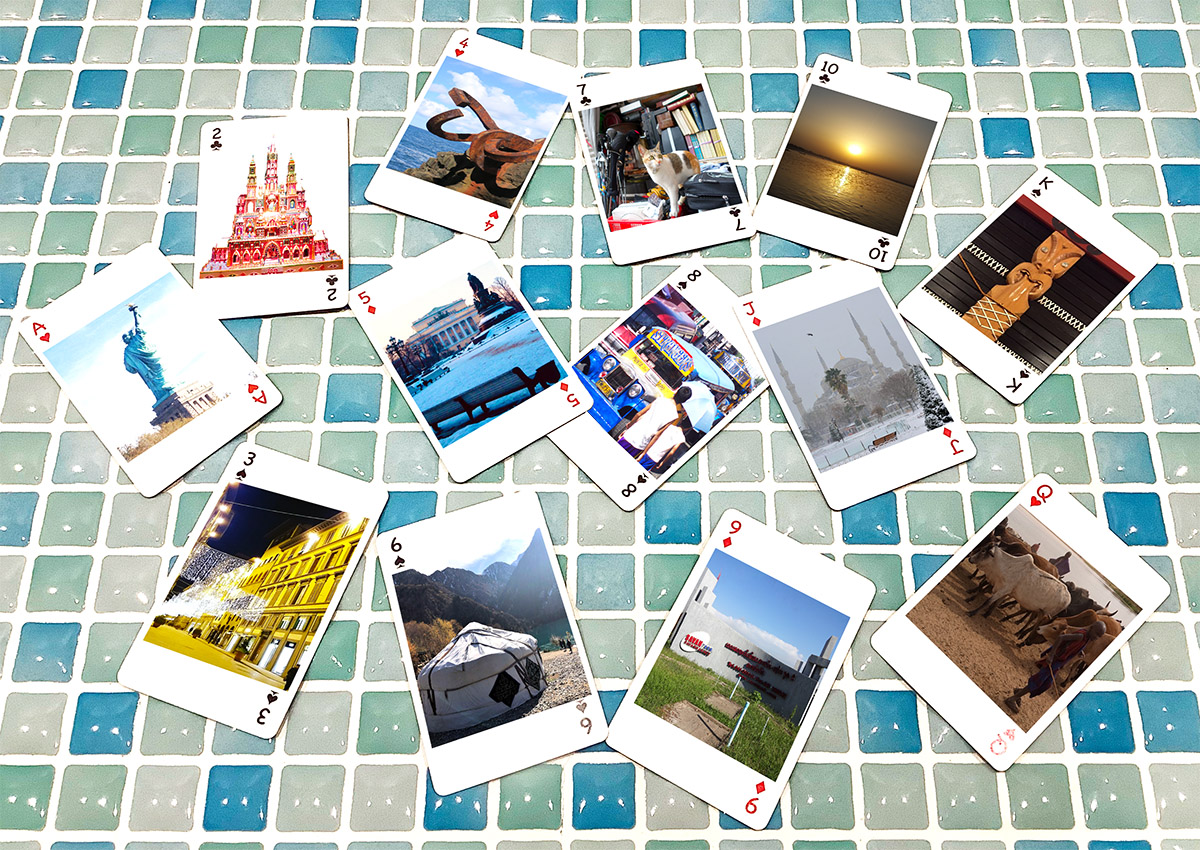
The School of International and Area Studies trains specialists in 13 areas. Students will acquire a wealth of knowledge about the "major area" and "major language" they chose at the time of admission, and acquire the ability to grasp the world from both the local and global perspectives.
- 1. Northwest Europe and North America
- 2. Central Europe
- 3. Southwest Europe
- 4. Iberia and Latin America
- 5. Russia
- 6. Central Asia
- 7. East Asia
- 8. Southeast Asia 1 (Islands)
- 9. Southeast Asia 2 (Mainland)
- 10. South Asia
- 11. The Middle East
- 12. Africa
- 13. Oceania
Across the Pond
Northwest Europe and North America
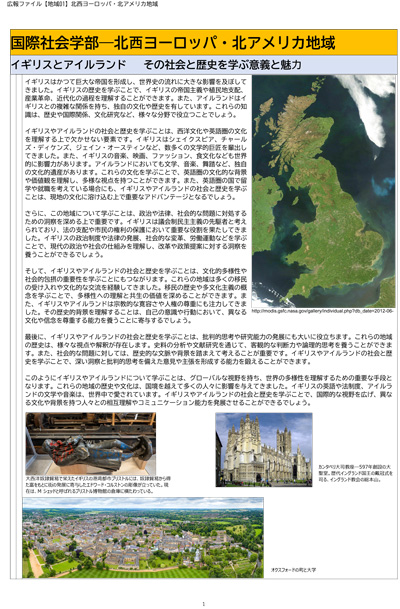
Looking at the map with Japan at the center, the United Kingdom and Ireland and the United States and Canada are located on the left side and right side, respectively. However, looking at the map again with the Atlantic Ocean in the middle, one can see that Northwest Europe and North America face each other across the ocean. The sea does not necessarily separate land; it also connects land. As a matter of fact, since the Age of Discovery, many people have crossed the Atlantic and traveled between the two continents for various reasons. While Northwest Europe and North America differ in some ways, they also share many common attributes. For example, when they refer to the “other side,” they say, “across the pond.” Calling the Atlantic a “pond” aptly captures the sense of distance between the two sides.
Languages by Major Areas: English
Studying the Present and Future by Learning from the Significance and Complexity of History
Central Europe
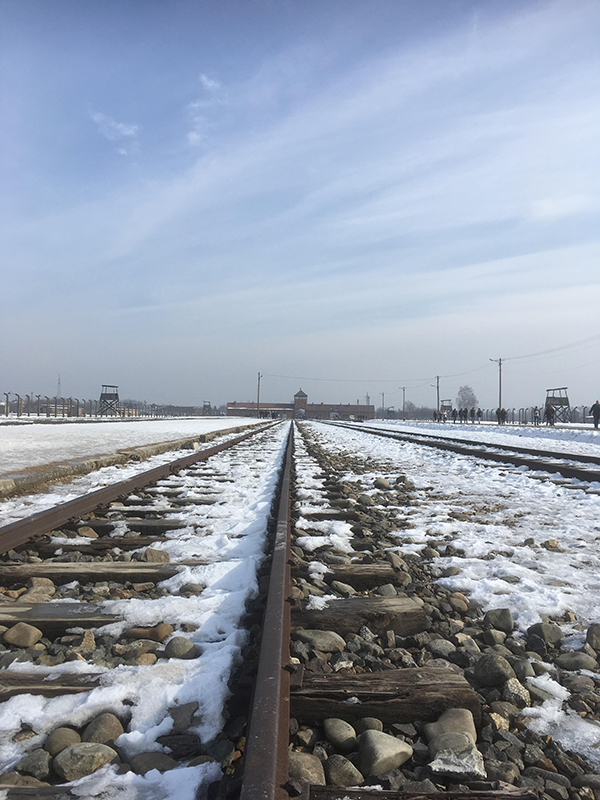
Central Europe consists of Germany and Austria, plus the Visegrád Four -- Poland, Czech Republic, Slovakia, and Hungary. Historically, it encompassed the vast territories of the Holy Roman Empire, the Kingdom of Poland extending to the Ukrainian steppe, the Kingdom of Prussia that rose on the Baltic coast, and the Kingdom of Hungary linked to the Ottoman Empire. Central Europe developed in this region from the diversity fostered by a mixture of several languages, cultures, and religions, with various cultures forming a multilayered single entity. It is at the forefront of environmental and refugee issues in Europe today, while repeated attempts have also been made to impose social controls on the capitalist economy. On the other hand, this region harbors a serious risk of xenophobia and has yet to achieve European integration across national boundaries. Nevertheless, the need to bring further dynamic changes to Europe is recognized, and Central Europe serves as its driving force.
TUFS offers courses to study the languages and cultures of Germany, Poland, and the Czech Republic, as well as their history and present within a wider regional perspective. Central Europe boasts of a very diverse region and complex history. As a region characterized by coexistence and conflict amid a crisscross of cultures and languages, Central Europe has had advance historical experience of the modern globalized world. Studying the issues of Central Europe will help nurture the rich knowledge and sensitivity needed for accurate understanding and solution of urgent issues in the modern world.
Languages by Major Areas: German / Polish / Czech
The Mediterranean Nurtures the Philosophy of Coexistence
Southwest Europe

France and Italy in Southwest Europe have a long history of cultural exchanges through the Mediterranean Sea and the Atlantic Ocean. This has produced the philosophy and culture of interaction and coexistence with others. The world-renowned literature, art, and philosophy of the Renaissance and the Enlightenment had the imprint of the process of trial-and-error in facing various historical “crises” over time, including war, European integration, and immigrants. Let us acquire the wisdom required to survive the modern society by studying this area.
Languages by Major Areas: French / Italian
The crossroads where civilizations encountered, clashed, and intermingled
Iberia and Latin America
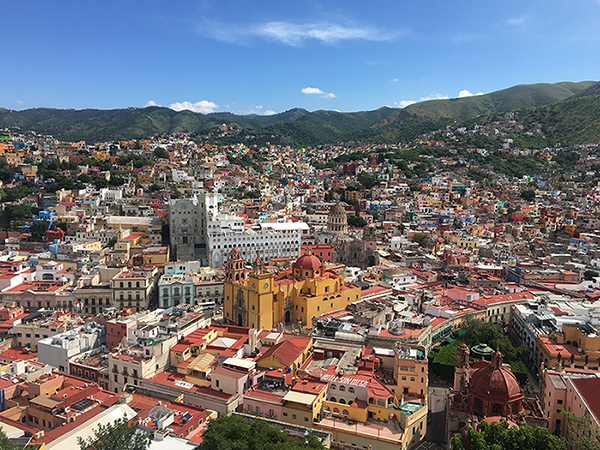
Iberia consists of Spain and Portugal. The Iberian Peninsula in Southwest Europe has been the “crossroads and meeting point between Europe and Africa and between the Mediterranean Sea and Atlantic Ocean.” The diversity of its climate and culture has given birth to colorful arts. At present, tourism and manufacturing are the mainstay of the economy in this area.
On the other hand, Latin America at TUFS refers to North, Central and South America, excluding the United States and Canada, plus the Caribbean. Its most fascinating feature is its turbulent history and cultural diversity. It includes regional powers like Brazil and Mexico, as well as some poorest countries in the world. In addition to people from the two Iberian colonial powers, its racial composition is a complex mixture of not only indigenous people and mestizos (mixed-race), but also African, other European, and Asian (including Japanese) descendants, as well as Middles East immigrants. It also has a rich vibrant natural environment, from the Andes Mountains that run across the South American continent to the great Amazon Rainforest.
Languages by Major: Spanish / Portuguese
A Multiracial Land Alive with a Turbulent History
Russia

― Developing an eye for understanding and analyzing the past and present of Russia and its vicinity, which is currently destabilizing the international community ―
”Russia” is essentially the name of a country. Its geographical sphere has fluctuated with the rise and fall of the country from the Russian Empire to the Soviet Union to the present Russian Federation. Its vast territory is home to over 100 ethnic groups and a wide variety of languages and religions. It has produced such excellent culture as literature, classical music, ballet, and opera, but historically, this has often been embroiled with the ideology unifying this multiracial state. The Russian Federation, which has rich natural resources and enjoys a strong presence in the global economy, shocked the international community with its invasion of Ukraine in 2022. This course offers a comprehensive study of Russia and its surrounding areas with the aim of gaining an analytical understanding of the situation there.
Languages by Major Areas: Russian
Vibrant Crossroads of Civilizations
Central Asia
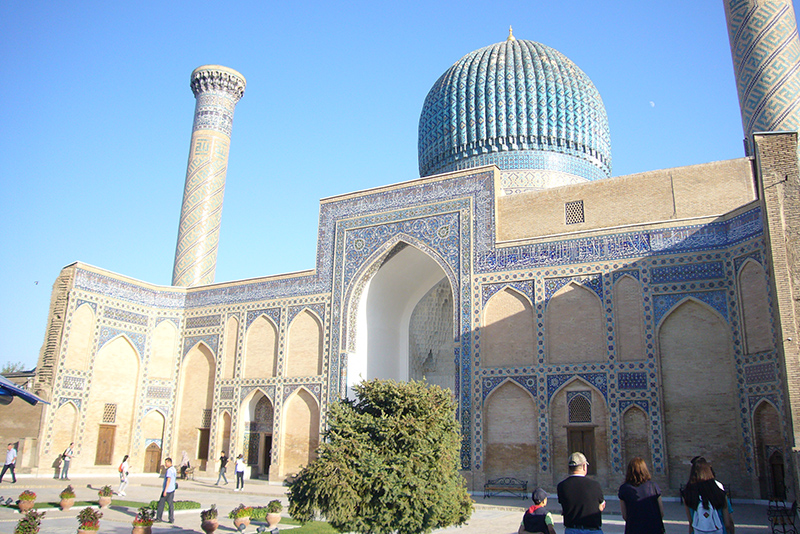
TUFS’s study of Central Asia covers five former Soviet states – Uzbekistan, Kazakhstan, Kyrgyzstan, Tajikistan, and Turkmenistan – and Mongolia. This region, dotted with grasslands and oases, has prospered as the crossroads of civilizations, characterized by the vitality of nomads, peasants, and citizens. Here, the Mongol Empire achieved a loose unification, allowing the Iranian and Turkic peoples to nurture their unique Islam-based cultures and the Mongolians to develop their own Tibetan Buddhism-inspired culture. These countries are also characterized by their common experience of revolutions under Soviet influence and about 70 years of socialism. After the end of the Cold War, this region has gained greater geographical importance in the new international relations. TUFS’s course on Central Asia offers an in-depth study of nationalism, diplomacy, transition to a market economy, conservation of the ecology, revival of traditions and religions, and other political, economic, social, and cultural issues from the basics.
Languages by Major Areas: Mongolian / Russian and Uzbek
Prospective students choose either “Mongolian” or “Russian and Uzbek” when they apply for admission. Those who chose Mongolian start learning this language from first year, while those who chose “Russian and Uzbek” start with Russian in the first year and tackle both languages from the second year.
From Here: So Near Yet So Far
East Asia

― Imagining/creating our future by encountering real-life East Asia first ―
The main subjects of study of the East Asia course are China (People’s Republic of China and Republic of China) and Korea (Democratic People’s Republic of Korea and Republic of Korea). The history of this region is so complicated that it is even necessary to explain what is meant by China and Korea at every turn. Japan is very much involved with this history, and for this reason, these countries are termed “so near yet so far” in Japan. However, let us transcend the framework of “country.” If we go beyond the framework of “Japan-China relations” or “Japan-South Korea relations,” meeting real-life people living in East Asia will allow real-life you to find partners who will create the future with you.
Languages by Major Areas: Chinese / Korean
The Greatest Expanse of Sea and Islands in the World
Southeast Asia 1 (Islands)
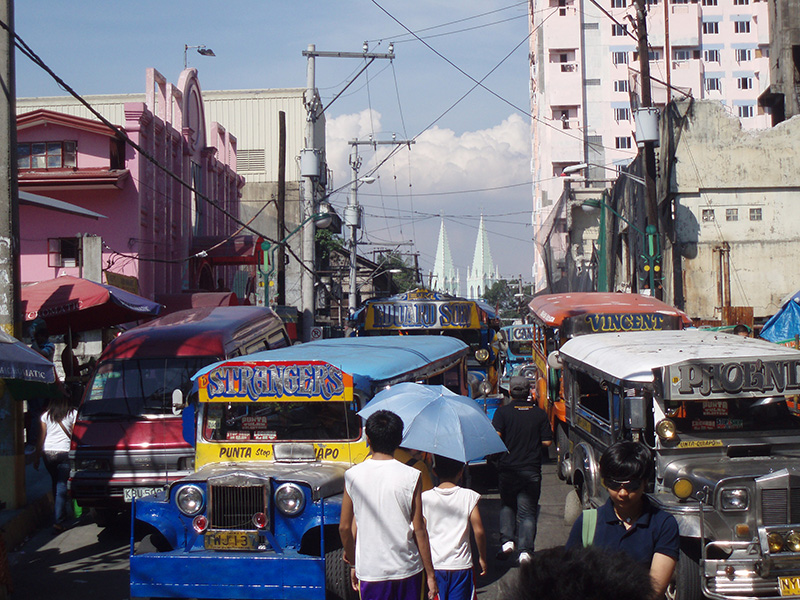
Southeast Asia 1 consists of island Southeast Asia. This is the largest expanse of sea and islands in the world located between the Pacific and Indian Oceans. Over 400 million people live in the six island states of Southeast Asia (Indonesia, Malaysia, the Philippines, Singapore, Brunei, and East Timor).
Since ancient times, diverse cultures have mingled and coexisted in island Southeast Asia, where people and goods moved around through the sea. Here, a fascinating multifarious world has been formed that is referred to as the “microcosm of Asia.” There are many values that we can learn from island Southeast Asia, such as “loose ties within diversity” and “flexible and open networks.” Let us reexamine the world from island Southeast Asia.
Languages by Major Areas: Indonesian / Malaysian / Filipino
Convergence of Rich Natural Environment and Economic Development
Southeast Asia 2 (Mainland)
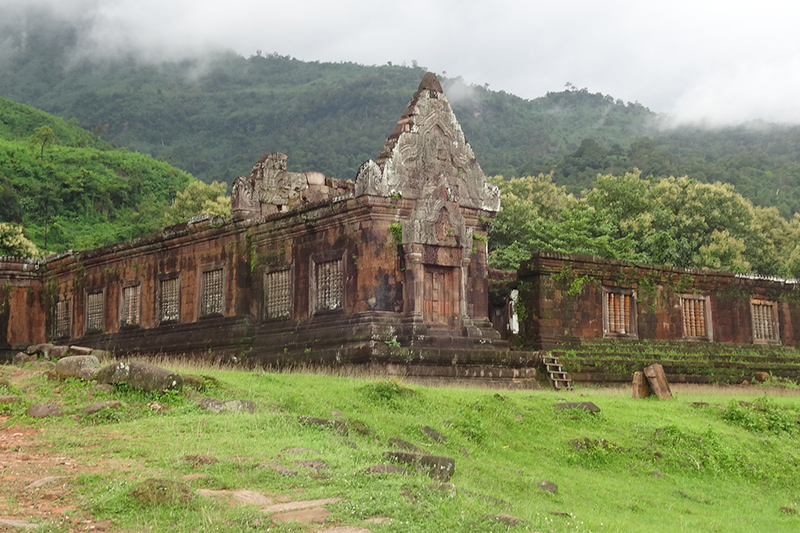
― Rich Natural Environment and Economic Development – Greater Mekong Subregion with Close Ties to Japan ―
Southeast Asia 2 consists of five nations: Vietnam, Laos, Cambodia, Myanmar (Burma), and Thailand. This area features highlands and basins across the Indochina Peninsula and deltas formed in the Mekong River and other rivers and estuaries, big and small. Agriculture, particularly rice farming, thrives in this rich natural environment. Many Japanese companies are doing business there in recent years, and industrialization is also progressing. Furthermore, a transportation network has been built on the Indochina Peninsula that enables vigorous exchanges of people, goods, and money across national boundaries, putting the Greater Mekong Subregion in the limelight. This area also has close ties with Japan through international cooperation, business, and cultural exchanges. Let us consider the problems plaguing the international community by studying the languages, history, politics, economy, and culture of continental Southeast Asia.
Languages by Major Areas: Vietnamese / Laotian / Cambodian / Burmese / Thai
Engendering Diversity and a Great Future
South Asia
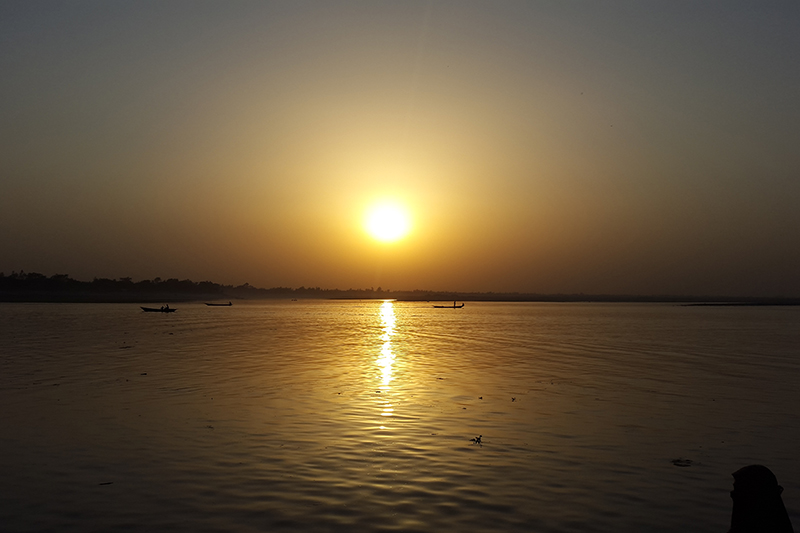
South Asia is a region consisting of India, Bangladesh, Pakistan, and five other countries. Its total population has reached 1.9 billion in 2021, which means about one-fourth of humanity lives here. Furthermore, Hindi, Bengali (Bangla), and Urdu studied at TUFS are among the most spoken languages in the world.
South Asian countries have close historical ties, and numerous languages, ethnic groups, and cultures coexist across the boundaries. South Asia is an exciting region where economic development cohabits with poverty, environmental issues, and other unsolved social problems. The increasing presence of South Asian people is also becoming part of daily life in Japan and many places worldwide.
Let us study this dynamic South Asia from a comprehensive perspective based on a historical and social point of view to deepen our understanding of our modern world.
Languages by Major Areas: Urdu / Hindi / Bengali
To Know the Middle East is to Know the World
The Middle East
― This fascinating region with rich history, culture, and resources holds the key to solving the world’s problems ―
The West Asian and North African countries commonly known as the Middle East consist of the 22 Arab League member states, Iran, Turkey, and the Caucasian Countries. It is home to people who speak Arabic, Persian, Turkish, and so forth as their mother tongue. The Middle East often comes with the negative first impression of conflict, terrorism, and refugees. However, it did not create these problems; they are the result of the world fighting over the “cradle of civilization” with its rich history, culture, and resources born out of the Nile Civilization, Mesopotamian Civilization, Ancient Greek and Roman Civilization, Judaism, Christianity, and Islam. The Middle East is the quintessence of the world’s problems, and the key to solving these problems lies in understanding this region.
Languages by Major Areas: Arabic / Persian / Turkish
Africa: Coming to Grips with this Vast Continent is a Great Challenge
Africa
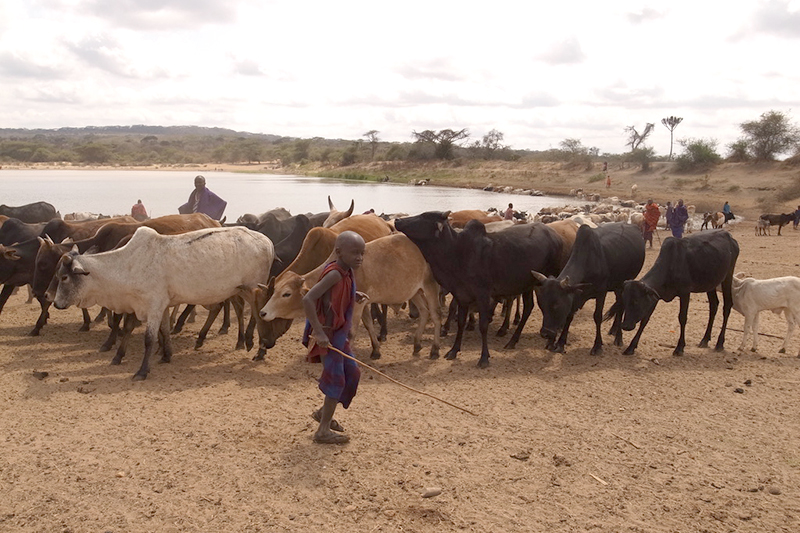
Africa is a vast continent larger than Europe, North and South America, China, and other countries combined. Its dynamism can also be seen from the diversity of its natural environment consisting of deserts, savannas, tropical rain forests, and other climactic zones. Africa used to be associated with the negative image of conflict, poverty, and other problems and has been regarded by the international community as a “problem” that needs to be solved. However, there has been a dramatic change in Africa’s position in recent years. Its growth potential is now in the limelight as it is being recognized as the new frontier for businesses. However, Africa is too enormous a region to be regarded as a single entity. A closer look at the minutiae of the people’s daily life shows that there is an infinite number of diverse realities impossible to capture in one word. We hope to come to grips with the reality of Africa as much as possible as if trying to touch an elephant to check it out.
Languages by Major Areas: English (major) / French, Arabic, Portuguese (required elective), Swahili (recommended)
The curriculum for studying English for Africa is separate from that for North America and Europe. Sometimes joint classes are held with students studying Oceania.
Rethinking the “Norm” through the Sea and the World of Adventure
Oceania
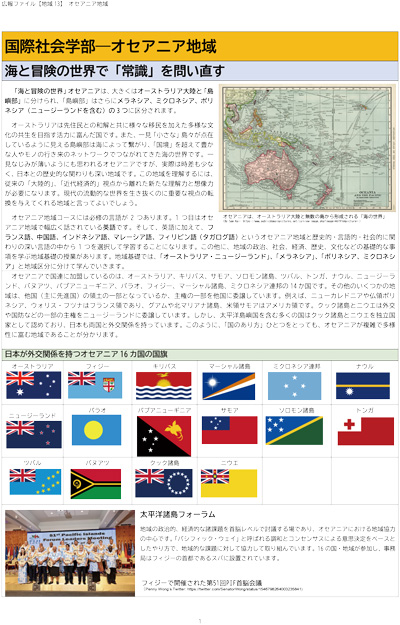
Oceania is composed of four areas: The Australian continent, and the islands of Melanesia, Micronesia, and Polynesia.
Australia is a relatively young country engaging in reconciliation with Indigenous Australians and multicultural coexistence with various immigrants. The Pacific islands may appear to be “small” and scattered over the ocean. However, people in this area are connected by the sea and created a prolific exchange network before “national boundaries” were introduced by colonialism.
Although it might sound unfamiliar, Oceania has considerable historical ties with Japan. It is relatively close to Japan and had been connected with the aforementioned trade networks. Some parts of Oceania were under Japanese rule until World War II.
To understand Oceania, we need to overhaul the taken-for-granted view of the world. ‘Small islands dispersed in the vast ocean’ are actually nodes of rich and prosperous networks which criss-cross the entire Pacific Ocean. People who were colonised and disparaged, actually lived in prosperous relationships with living creatures and the environment. This region may give important clues to surviving this modern world.
There are two required languages for the Oceania course. First, English, which is widely spoken in Oceania. In addition, students must select another language from French, Chinese, Indonesian, Malaysian, and Filipino. These five languages have strong historical, linguistic, and social ties with Oceania.
